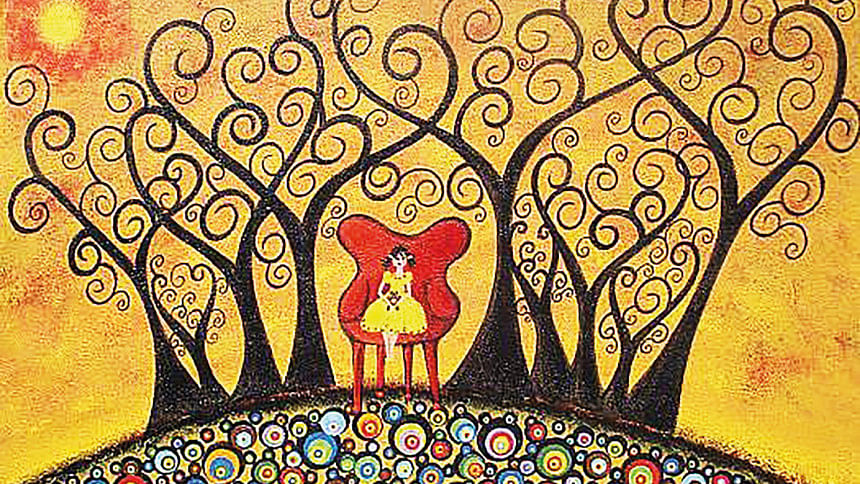Ah, storytelling!

Do the smooth muscles of narrative hold a deceptive appeal? Does the temporality of a story do more harm than good? One of the most intriguing stories in Aesop's Fables, seems to think so – a fascinating story that is a good example of an anti-story!
The orator Demades, having failed to gain the attention of a noisy and distracted Athenian audience, offers a story, to which the audience is immediately all ears. "The goddess Demeter, a swallow, and an eel," the fable goes, "were walking together down the road. When they reached a river, the swallow flew up in the air and the eel jumped into the water." And then Demades falls silent. Impatiently, the audience cries, "And what about the goddess?" Demades' reply comes like whiplash: "She's angry at you for preferring Aesop's fables to politics."
Are stories more seductive than politics? Contemporary South-Asians might differ here from the ancient Greeks. Not least because so much politics around us are like spun yarns in their shine and jazz.
But what is exactly the promise with which the story lures its audience? What is the twist that wrenches suspense from their guts, leaving them hanging breathlessly?
Many writers, I think, remember the childhood recipe of story-making: "Once upon a time, there was a king and a queen. One day the queen died. And then the king died too." "That is not a story," we were told. But how about this? "Once upon a time, there was a king and a queen. One day the queen died. And then the king died of grief."
"Now that," our teachers exclaimed excitedly, "is a story." Howsoever tiny. Events make up a story only when they are part of a causal link, leading up, ideally, to a moment that stages a climax and a closure.
This is the obvious question that looks into our face from the old art-life debate: Is narrative impossible without an event? That is, can we narrate only when something has happened? And what, indeed, is an event? Is an event a necessary departure from everyday life – indeed, is it the very opposite of the ordinary everyday? Is it only a deviation from the repetitive temporality of the everyday that becomes marked as an event? Is narration possible when nothing out-of-the-ordinary has happened? Is the lack of this happening narratable, or does it defy the very fundamental condition of narrative?
The arrival of literary modernity with the Enlightenment in 18th century Europe gave birth to the English novel. One of the unique gifts of the novel was that it showed the ordinary everyday as worth narrating, just the way ordinary people were now to be celebrated as protagonists in literature, unlike the royal and the highborn in ancient Greek or Shakespearian tragedy. Pre-modern prose narratives such as the romance or the travel story narrated the fantastic, the exotic or the extra-ordinary as experienced by kings, knights and heroic travellers; the distinguishing mark of the new art form of the novel (its newness signalled by its very name) was that it told stories of middle- and even working class women and men, and told stories of kitchens and drawing rooms and card-games and afternoon teas. Suddenly the dailiness of daily life became the stuff of narration. A new word became crucial to fiction: "verisimilitude" – life-likeness. While previous narratives were valued for their departure from the ordinary everyday into the realm of the fantastic, the modern novel began to be valued inasmuch as it showed itself as rooted in the very conditions of everyday life.
The fantastic and the extra-ordinary did not vanish but moved into the realm of the popular, while the conscious artistic imagination became committed to the demotic and the quotidian. In the early 19th century, Walter Scott's novels about war and romantic adventures were runaway bestsellers. But it is his contemporary Jane Austen, with her gossipy stories about ladies' drawing rooms and tea parties who is considered a classic today and the then-bestselling Scott has been consigned to a distant second alley of the literary canon.
The Italian critic Franco Moretti reads Austen's Pride and Prejudice as containing only three turning points. Elizabeth and Darcy meet in Chapter 3; she is disgusted by him. Action is set by this disgust. 31 chapters later, Darcy proposes to Elizabeth. 27 chapters later, Elizabeth accepts him. These are the only three "events" that shape the trajectory of the plot. In between, they meet, talk, hear other people, have tea, go for walks, the sort of thing that adds texture and density to the novel, but do not affect the story. Moretti calls them "fillers." Next to 3 turning points, he counts 110 fillers in the novel. The modern genre of the novel, it appears draws more of its substance from fillers than from turning points.
And then Moretti notices something curious. As the nineteenth century moves on, fillers are on the rise. The background, he says, slowly starts to become the foreground. From simply giving shape and texture to novels, drinking tea and doing laundry became the very subject of the story, thereby violating the assumption that the narratable event is necessarily a departure from the routinized everyday. The triumph of the non-event, one might say, climaxes with modernism, the period when a whole story comes to be made up of staring at a mark on the wall and a door-stopper of a novel outlines a single day where two men wander around the streets of Dublin.
If the poetic is understood to be an immersion in the experience of a moment and the narrative is imagined as a temporally activated account of causally linked events, modern literature comes to demolish the binary opposition between the two.
But this is the story of the West, right? The common claim about South Asia is that it is, and remains forever, a storytelling culture. It is the land of epics, orality, folklore, mythical tales embedded in communal memory – all the way from the ancient sages to the prolix politician in the modern parliaments and election campaigns. The South Asian Demedes, according to this imagination, would plunge into a story right away, not bother with abstract theories of the state. No conflict between the statesman and the storyteller in these lands, none at all!
It is curious how the English novel from the Indian subcontinent has become a visible venue of this claim, especially since the 1980's; how it has been constructed as an alternative to the realism of the modern western novel. Polyphony, the mistrust of reason, a privileging of orality over literacy, all were by this time part of the West's anxiety about its own project of rational modernity. These were gestures through which the West was questioning its own Enlightenment that now conveniently found simultaneous celebration in non-western cultures of irrational, magical storytelling.
Sure, stories have always played a key role in the South Asian imagination – if the latter can be imagined with any kind of unity. But to construct the playful, prolix, fantastic storytelling culture of South Asia as an alternative to modern western rationality and its literary values – now, that too, is a new kind of orientalism, isn't it? What else but a new version of the taxonomy that classifies the West as rational and scientific and the nonwest as irrational and colourful?
It is, in the end, impossible to dismantle storytelling as a magnetic force that has held our imagination in thrall over centuries. Nor is it desirable that we do so. The important question to ask is: are there other elements that claim artistic attention? Have we left them on the wayside in our fateful march of globalization, which is one of the most powerful and inescapable stories that run our lives today?
***
Saikat Majumdar's novels include The Firebird (2015), The Scent of God (2019), and the forthcoming The Middle Finger (2022).

 For all latest news, follow The Daily Star's Google News channel.
For all latest news, follow The Daily Star's Google News channel. 



Comments